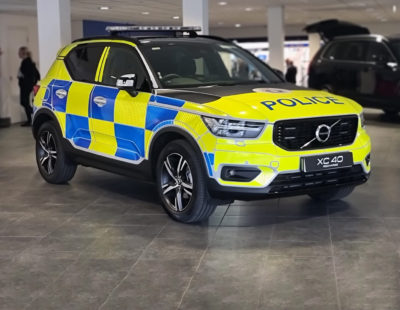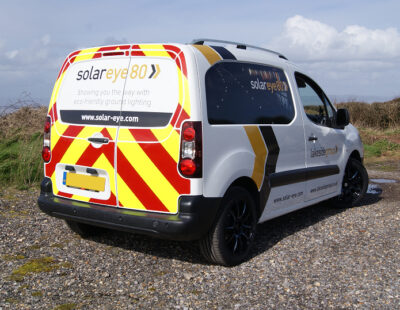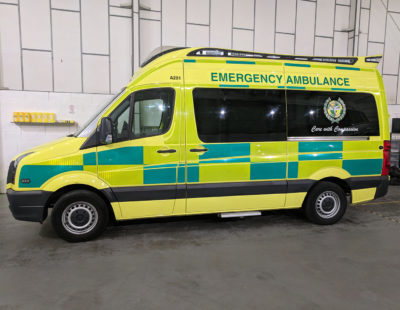When it comes to emergency service vehicles, visibility is key. Markings play a vital role in the identification and visibility of emergency service vehicles, helping them to be conspicuous at all times of day and reach emergencies faster. Therefore, when it comes to purchasing these markings, buyers must ensure the quality, durability, and compliance of products.
As all emergency vehicles in the UK are instantly recognisable due to their uniform style, any new emergency vehicles must be properly wrapped in the correct markings. In this buyer’s guide, our expert team at Lakeside Group, UK suppliers of industry leading Avery Dennison reflective material, explain all there is to know about emergency service vehicle markings, regulations, and where to buy them.
Types of emergency service vehicle markings
The majority of emergency vehicles, including police cars, fire and rescue vehicles and ambulances, use the recognisable battenburg pattern. These squares of alternating colours are a staple of UK emergency service vehicles.
Find out more about battenburg markings >
Although most emergency service vehicles use this same pattern, the colours used vary. Generally, the lighter colour tends to be fluorescent for daytime visibility, whereas the darker colour tends to be retroreflective, to ensure night time conspicuity. By reflecting light back to the source, retroreflective materials help to ensure emergency service vehicles are always visible, even in dark or foggy conditions.
Find out more about reflective materials for vehicles.
Police car markings
In England, police cars usually have rear chevron markings, side battenburg markings in blue and yellow, additional reflective materials (i.e. the squadron crest on the front of the vehicles), and lettering. Depending on the type and size of vehicle, the battenburg markings may be utilised more or less.
Read next: A Beginner’s Guide to Reflective Chevron Products
Ambulances
Ambulances, too, have rear chevrons, side battenburg markings in green and yellow, as well as the associated lettering and identification markers. You can find out more about ambulance reflective markings and tape in our recent blog.
Fire engines
Although commonly recognisable as large red vehicles, fire engines can slightly vary in appearance depending on the region within the UK. Usually, fire engines have rear chevrons, or at a minimum, reflective tape (ECE1014) that outlines the edges and contours of the vehicle. This type of reflective tape is useful for larger vehicles as it highlights the size of the vehicle in dark hours, reducing the risk of collision with any part of the vehicle.
Other emergency service vehicles
Motorbikes, other emergency services, and other vehicle sizes generally follow the above – utilising relevant colour combinations, battenburg pattern markings where appropriate, and relevant additional safety markings.
Importance of markings for emergency service vehicles
As mentioned above, markings are invaluable to emergency service vehicles. Below, we list some of the main reasons why.
Identity
Vehicle markings give the emergency services a clear identity when out and about, establishing authority, and reducing any confusion in the event of an emergency. They also act as trust markers, helping to instil confidence in the services for the general public.
Conspicuity
Emergency vehicles tend to travel at high speeds, may weave through traffic, and obstruct road users. It is therefore imperative they are seen in order to prevent collisions. This is especially critical when visibility is reduced due to conditions (i.e. night or fog), in which instance, reflective markings are vital.
Following on from the above, markings help to increase conspicuity when the vehicles are stopped. Similar to Chapter 8 and Safety at Street Works guidance, vehicles stopped on high speed roads should be appropriately visible, helped by reflective chevrons, to prevent collisions.
Visual Cue
Many emergency vehicles are characterised by their loud sirens, however those who are hard of hearing or in certain situations may not hear these. Therefore, the visual aide of markers help to draw attention to the presence of emergency vehicles.
Changed Behaviour
Central to the success of emergency services is the speed at which they are able to attend an emergency. Although all road users should be alert anyway, the distinct markings of emergency vehicles help to ensure the general public will respond to their presence as required – whether that be by moving aside for a police car, or taking additional care near a vehicle transporting human organs.
Reassurance
A secondary benefit of emergency vehicle markings is the reassurance they can offer someone in the event of an emergency. Whether someone is injured, or lost in need of search and rescue, seeing the distinctive markings can offer even the most distressed some peace of mind.
Emergency Service Vehicle Markings Regulations
It is clear the consistent use of stipulated markings is critical to the recognition of emergency services vehicles in the UK. The colours and markings style of emergency vehicles is outlined in the Road Vehicle Lighting Regulation 1989.
Materials for Emergency Service Vehicle Markings
Modern technology allows for flexible material with reflective properties to be applied easily to all manner of vehicles. Fortunately, this flexibility does not come at the cost of durability, as emergency service vehicle markings now tend to be extremely resilient to damage, resulting in little loss to reflectivity.
Using advanced micro prismatic materials, markings can be extremely reflective despite any damage, as well as offer industry leading levels of reflection. These products offer superior quality, of both longevity and reflectivity, compared to air gap vehicle markings materials.
Find out more with our blog: Air Gap vs Metallised Micro Prismatic Products – A Guide to Reflective Material Construction
Here at Lakeside Group, we supply Avery Dennison VisiFlex V-8000 – a leading reflective vinyl with numerous beneficial qualities perfect for application on emergency service vehicles. The micro prismatic makeup of this material makes it especially reflective, as well as durable, helping to achieve maximum conspicuity during dark hours. Available in six colours, including two fluorescent colours, Avery Dennison VisiFlex V-8000 is the material of choice for emergency service vehicles.
View the VisiFlex V-8000 Datasheet and Instructional Bulletin for more information – or get in touch with our team!
Where to buy vehicle markings for emergency services?
It is critical that buyers source from reputable, trusted suppliers – especially those with knowledge and experience of emergency vehicles.
At Lakeside Group, we work with the emergency services to achieve safe, conspicuous, and durable emergency vehicle markings that last for years. We have a full range of case studies verifying our continued success in assisting emergency services.
Emergency vehicle markings from trusted suppliers
For quality emergency service vehicle markings you can trust, get in touch! Our experienced team know all there is to know about emergency vehicle legislation, ensuring compliance is met at all times. Alongside our partner Avery Dennison Reflective Solutions, we keep emergency service vehicles across the UK decorated in the latest, most effective materials for retroreflective vehicle markings.
If you need help sourcing durable safety markings for emergency service vehicles – or any number of other requirements – contact us!
See more: A Beginner’s Guide to Vehicle Safety Markings
See more: A Buyer’s Guide to Reflective Vinyl




